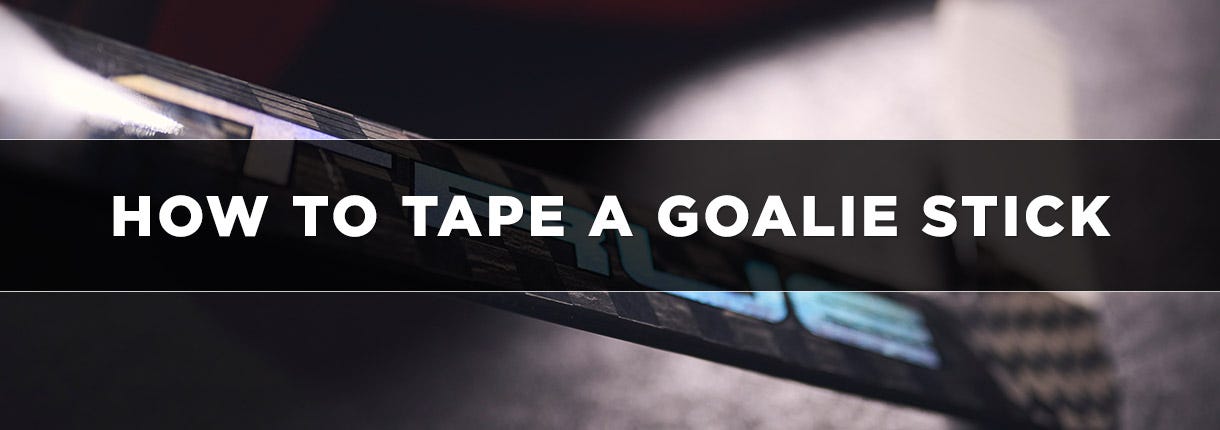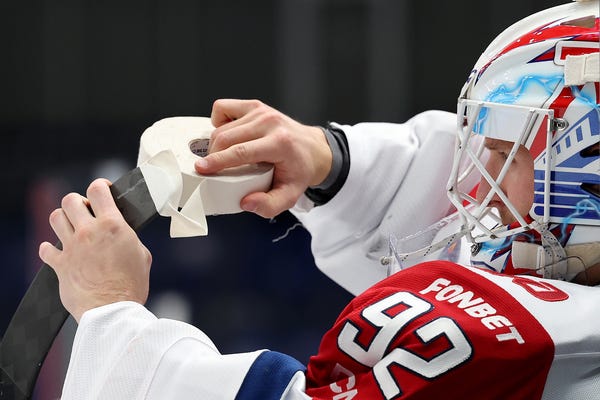How to Tape a Goalie Stick: Step-by-Step Guide for Beginners

Taping a goalie stick is important for players at all skill levels, as it enhances grip, control, and durability. For beginners, taping helps them establish a secure hold on the stick and learn proper hand placement, which is crucial for developing good stickhandling and save techniques. For experienced players, taping offers additional customization; they often tape the blade and shaft according to personal preferences, which can impact puck handling and improve shot control. The tape adds cushioning that absorbs puck impact, extending the stick’s lifespan while helping goalies reduce vibrations and maintain control during intense gameplay. Properly taping the stick is a fundamental yet customizable skill that benefits goalies’ performance on the ice.
In this article, we will discuss:
Why Do You Tape a Hockey Goalie Stick?
Grip
Taping the handle of a goalie stick is crucial for ensuring a secure grip, which helps goalies maintain control during fast-paced play. A non-slip surface prevents the stick from slipping in their hands, allowing for better handling, especially when making quick saves or passes
Puck Control
The tape applied to the blade enhances puck control by increasing friction. This added grip allows goalies to more effectively handle and deflect pucks, improving their ability to redirect shots and make accurate passes to teammates. The texture created by the tape can significantly influence a goalie’s performance during games.
Protection
Taping the blade also serves a protective function, shielding it from damage caused by impacts with the ice and pucks. The tape absorbs some of the shock, reducing vibrations that can affect the goalie’s feel for the stick. This protective layer prolongs the stick's lifespan and ensures consistent performance, making it an essential maintenance practice for goalies
Why Do You Tape a Hockey Goalie Stick?
Hockey Tape:
- Cloth Tape: Typically used for the blade and handle, offers good grip and durability.
- Vinyl Tape: A popular choice for the handle due to its sticky surface and comfort.
Scissors: Useful for cutting the tape to the desired length, ensuring clean edges and a neat finish.
Heat Gun or Hair Dryer (optional): Can be used to warm the tape slightly, making it more flexible for application and enhancing adhesion.
Taping A Hockey Goalie Stick: Step-by-Step


Taping the Blade
- Select the Right Tape: Choose a high-quality cloth or vinyl tape that provides a good grip and is durable enough to withstand impacts.
- Start Taping: Begin at the heel or the toe of the blade, applying the tape at a slight angle. Overlap the tape slightly with each wrap, creating a solid and consistent layer.
- Cover the Entire Blade: Continue taping up to the toe, ensuring the entire surface of the blade is covered. Aim for a smooth application without air bubbles or creases, which can affect puck handling.
- Add Extra Layers: For increased protection, especially on the blade’s edge, consider adding an extra layer of tape along the bottom edge, which can help absorb impacts and reduce wear.
- Smooth the Tape: Use a squeegee or credit card to smooth out the tape, ensuring it adheres properly and has a tight fit.
Taping the Shaft
- Choose the Right Tape: Opt for a high-quality, non-slip cloth or rubber grip tape that provides a firm hold and is durable enough to withstand repeated use
- Determine Tape Length: Measure the desired length of tape you want to apply. Typically, the tape should cover the area where your hands grip the stick, allowing for both upper and lower hand placements
- Start at the Top: Begin taping at the top of the shaft, wrapping the tape around in a spiral manner. Ensure the tape overlaps slightly to create a consistent grip surface without gaps
- Customize Thickness: For enhanced comfort and control, consider applying multiple layers of tape to create a thicker grip. This can help absorb vibrations and reduce hand fatigue
- Create Grip Patterns: Experiment with different taping patterns, such as horizontal or vertical stripes, to customize your grip feel. Some players prefer textured surfaces, which can enhance control
- Finish Neatly: Cut the tape cleanly at the bottom and press down firmly to secure it. Ensure that the edges are smooth and that there are no loose ends that could peel during play
Taping the Knob
- Use Tape for a Custom Grip: Start by wrapping tape around the end of the stick to build up a knob. Use a cloth or rubber grip tape for added texture and comfort, ensuring it fits your hand size and grip preference
- Create a Flared Shape: When taping, gradually increase the width of the knob by wrapping the tape in a flared shape. This design helps prevent your hand from slipping off during play
- Add a Cork or Rubber Cap: Consider attaching a cork or rubber cap at the end of the stick for added comfort and cushioning. This can absorb shock and provide a more ergonomic grip
- Experiment with Different Materials: Some players opt to use foam or silicone grips, which can be molded or cut to the desired size and shape. These materials can enhance comfort and provide a unique feel
- Adjust the Thickness: Customize the thickness of the knob to suit your hand size. If you have larger hands, add more tape or material to increase the diameter, while smaller hands may benefit from a slimmer profile
- Test for Balance: After creating the knob, hold the stick to ensure it feels balanced and comfortable. Adjust the size and shape as needed until you find the optimal fit
- Secure the Knob: Once satisfied, make sure the knob is securely fastened by wrapping additional tape around the base to prevent any movement during play
Maintaining Your Goalie Stick Tape Job
Inspect Regularly: Frequently check the tape for wear and tear, especially after games or practices. Look for frayed edges or peeling, and replace or retape areas as needed to ensure optimal grip and protection
Store Properly: When not in use, store the stick in a cool, dry place away from direct sunlight. Extreme temperatures and humidity can degrade the tape, causing it to lose its adhesive properties
Clean the Tape: Keep the tape clean by gently wiping it with a damp cloth to remove dirt and ice build-up. This prevents the tape from becoming slippery and maintains its grip
Reapply as Needed: Depending on the frequency of use, reapply tape every few games or practices. A fresh tape job not only enhances grip but also protects the stick better than worn tape
Avoid Excessive Moisture: After games, dry the stick thoroughly to prevent moisture from compromising the tape. If the tape gets wet, dry it off gently without pulling at the tape itself.
Use Quality Tape: Invest in high-quality tape specifically designed for hockey. Cheaper tapes may not hold up as well under game conditions, leading to more frequent reapplications
Maintain a Consistent Taping Technique: Stick to the same taping method and pattern for consistency. This will not only help in maintaining the effectiveness of the tape but also in creating a familiar grip that can enhance performance











